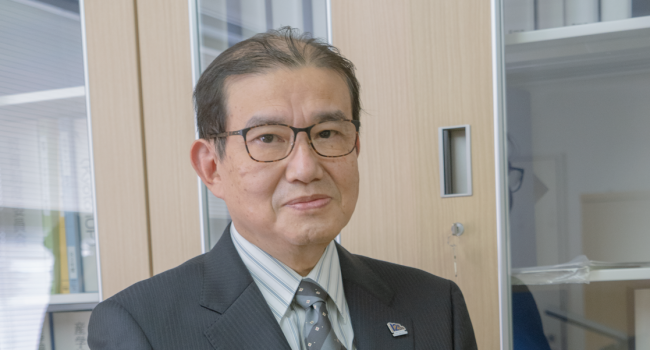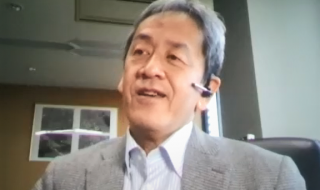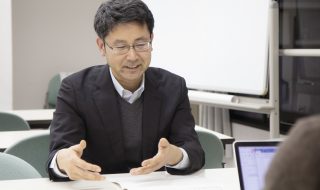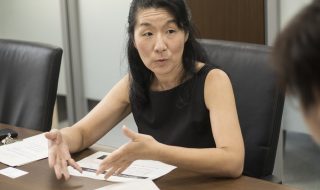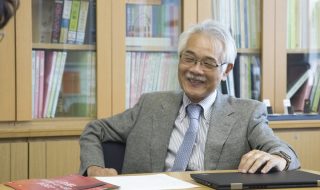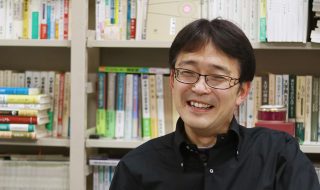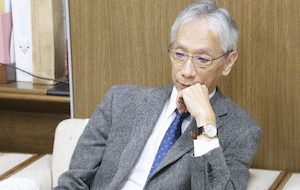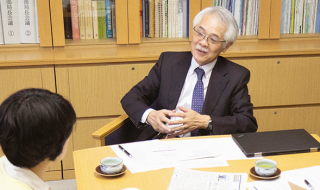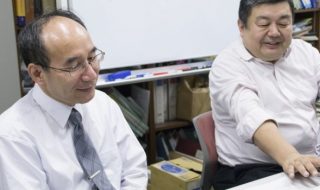This is an extended version of our interview with Dr. Hirajima originally published in “Kyoto University FD 2020.”
In this interview, Dr. Takao Hirajima, who assumed the position of Executive Vice-President for Education, Information Infrastructure, and Library Services, on October 1, 2020, talks about his goals as Executive Vice-President for Education and discusses the future direction of Kyoto University’s education.
Late Specialization and Student Support
In your previous position as Dean of Graduate School and Faculty of Science, what were your goals in terms of education and how did you achieve them?
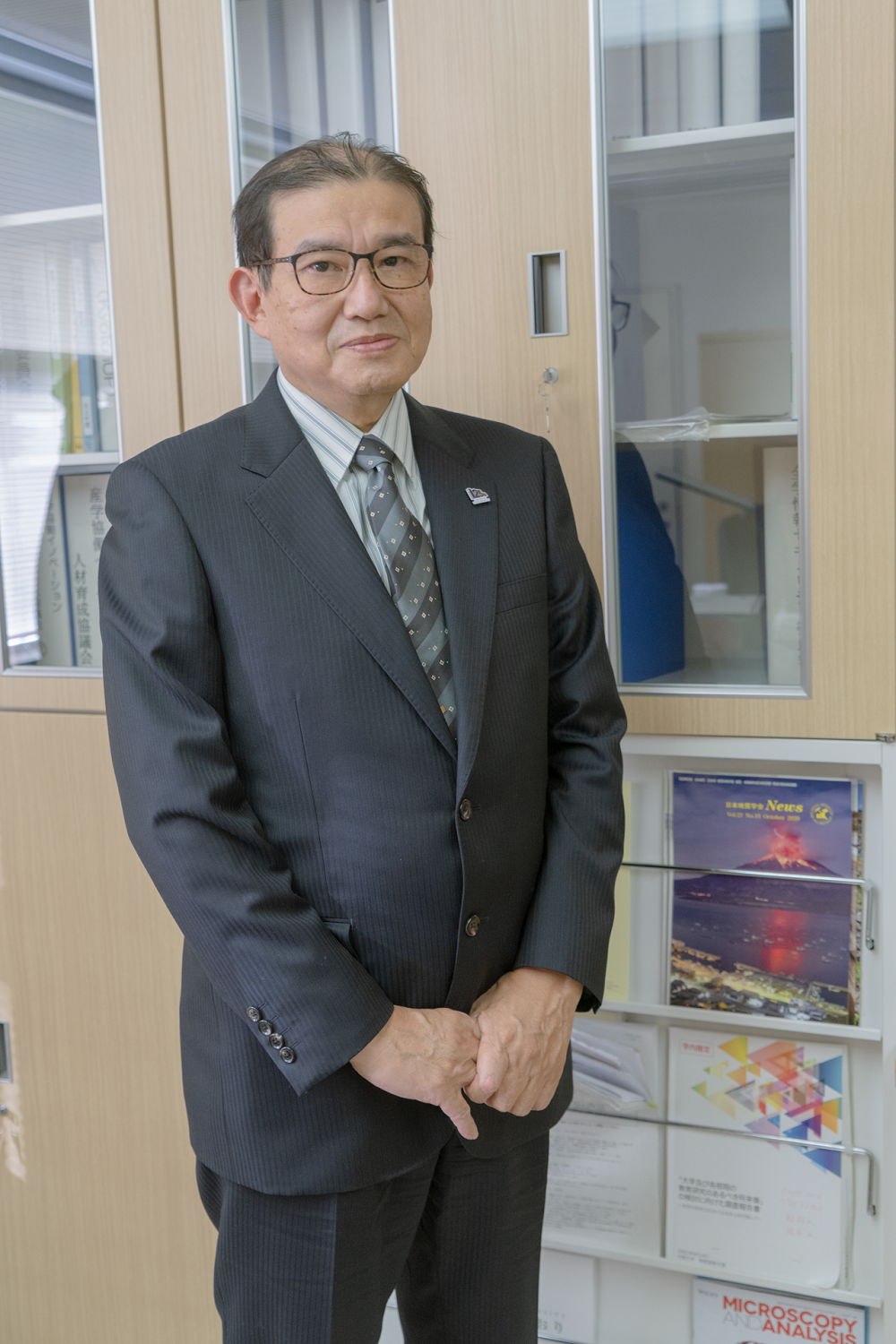
As I assumed my executive position this fall, I grabbed a copy of the Faculty of Science’s “Curriculum Guide” and packed it in the first box to be relocated to the executive office. The guidebook begins with the Graduate School and Faculty of Science’s educational philosophy, and how to integrate this philosophy into our school curriculum was our long-time quest. The Graduate School and Faculty of Science values academic freedom, which is also imprinted as Kyoto University’s motto, therefore offers students the freedom to tailor their study to their academic interests and needs. Likewise, up until the 1990s, there were no compulsory courses in the Faculty of Science, based on an assumption that talented and highly motivated students would be able to guide themselves to study of their own free will. I think this system works well with highly motivated students, whereas it should be challenging for the students who entered the school without a clear academic plan. So, for talented and highly motivated students, we leave them to decide their direction of study from the beginning. Even with the CAP system, the Faculty of Science allows students to register for maximum credit hours of 34 for the spring semester of the freshman year, so they can gain a basic yet broad understanding of different disciplines at the onset of their academic life. From the fall semester of the freshman year onward, we do not set an upper limit on the number of credits students can register for, on the condition that they have earned at least 16 credits of As or higher in the previous semester. Under the system, while we do not have to worry so much about talented and highly motivated students, we should care and support extensively for those students who entered the university without a specific purpose and those who have fallen behind.
As depicted in the manga “Let’s Play with Numbers,” many students in the Faculty of Science experience a stumbling block in their first year of mathematics. Honestly, I was one of them. In my first-year mathematics class, the professor abruptly said, “Only 50% of you will pass my course.” His course was thus hard. I couldn’t catch up with the class at all. In reality, this is where the first hurdle lies. Under such circumstances, who extends a helping hand and saves students from falling behind are their classmates and faculty members. To help establish such a communication channel for students, the Faculty of Science assigns a mentor to a small group of students. Mentors carefully pay attention to the students with poor performance, and occasionally set up a meeting to talk with them and their parents together, especially if a student fails to proceed to the upper year or if a student’s grades drop significantly. This approach has been well perceived despite that students meet their mentors only twice a year during their first and second years. It helps students get used to the new environment quickly, and they can opt to study under their mentors if they find it difficult to start a new major from the third year on. While most students, even those with poor performance, come to talk with their mentors, we have had a hard time convincing some students who do not show up for counseling. At the end of the second year, students select one of the five majors to study more professional courses. We take time to hold guidance sessions on each division and explain their policies and goals several times to navigate students’ decision making. The second hurdle that typical students in the Faculty of Science stumble at comes in the winter of the first year of the Master’s program. Most undergraduate students who directly proceed to the graduate program do not start looking for a job until the winter of their first year in the Master’s program. They then start job hunting, but some feel depressed as they realize that they are not the ideal candidate that companies are looking for.
The Department of Science is the only department housed in the Faculty of Science, and the graduation thesis course (“research project”) is the only compulsory course for the undergraduate program. In the first two years, students are given opportunities to explore various academic disciplines and develop fundamental knowledge and skills, rather than focusing on a specialized field at an early stage. This is what is called “late specialization,” a strategy taken to help students shape their professional goals from their learning experience. For this purpose, students are encouraged to organize “self-directed seminars,” where they set their own research themes and present their findings. We support their efforts by making seminar rooms available for their use, and by participating in student-organized journal clubs. I myself organized self-directed seminars when I was an undergraduate student. In my first year, I asked one assistant professor to join me with reading journals. In my third year, I found a specific topic that I was interested in studying, so I asked my professor and assistant professor for their guidance. They kindly suggested one English book and said, “Let’s read this book together.” I really appreciate their dedication and professionalism. Generally, during the first and second years, students find out where their aptitudes lie and observe their performances in the classroom, to get ready to go to the next stage. They may experience setbacks along the way, but nevertheless, what we can do to support their academic life is to ensure their communication with classmates and faculty members, and to help them navigate systematically as they discover themselves in their studies.
Respect for Academic Freedom
Based on your former experience at the Faculty of Science, will you, as the current Executive Vice-President for Education, respect Kyoto University’s culture of academic “freedom” more than ever?
I must say that “freedom” is one of the hardest concepts to define. Freedom should be exercised but only when it is disciplined in its true sense. Not so many students can stand on their feet and live independently. “Freedom” does not mean that you have the liberty to act as you wish, but also it refers to the scientific ideas sprung from our creative minds. Free and creative ideas inspire us to develop a new technology that may change our social lives, or turn into a discovery that overwrites history. You never know that one small idea may make a big difference. Having said so, I can assure you that Kyoto University as a whole will stay committed to fostering the academic freedom of the students and faculty members. In academia, students and faculty members shall be treated equally. As freedom is a symbolic representation of Kyoto University’s academic culture. I hope that students proactively take their own initiative and enjoy the freedom to explore their intellectual interests.
Improving Student Support and Motivating Students' Engagement
Could you share with us your motivation as Executive Vice-President for Education? What do you think are the challenges faced by Kyoto University’s education?
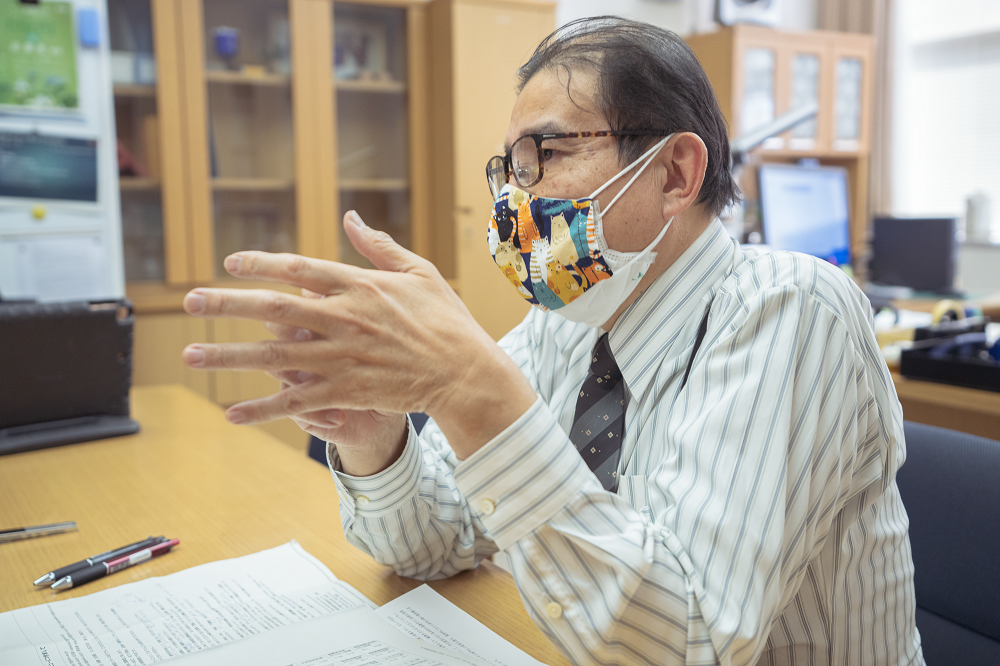
Responding to students’ diverse needs is one of our biggest challenges. In recent years, Kyoto University students’ academic levels, background, and reasons for dropping out of school have become very diverse. One of the responsibilities I took over from Dr. Kitano, the former Executive Vice-President for Education, is a council named C-ENGINE (Collaborative Education for Next-Generation Innovators & Exploration of Knowledge Intersections). There, I had a chance to talk with a person from a corporate background. He told me that there is a “2:6:2” rule applied to the staff composition of corporate organizations. He added, “The top 20 % is excellent, the middle 60% is functional if properly trained, and we don’t care for the bottom 20%.” This rule, however, does not apply to university education, leaving the bottom 20% unattended. Now I feel the pressing need to build a support system for the students in the bottom 20% range. One idea to do so is to improve the services of the Counseling Center. While some students come to the Center for counseling by themselves, some others do not have the guts to do so. What is even worse, the new coronavirus pandemic forced students to study from home and attend classes online. Consequently, some of them could not accommodate themselves well in the new learning environment and ended up not showing up for the entire spring semester. Our other challenge is how to motivate students. In normal times, I hold a welcome party as soon as new third-year students join my lab and help them make friends easily. My plot is to motivate the students who are allocated to my lab as their second preference. By working in groups through field research activities and making memories together with lab mates, students gradually get used to their new surroundings. However, the COVID-19 pandemic has deprived students of their chances to network with new friends, and I am worried about what this abnormal situation may entail. In the end, there are no right or wrong answers as to what to do with the students in the bottom 20%. All we can do is to make steady efforts. They may change for the better if we give them a little push to step forward. I can proudly say that students at Kyoto University are generally highly talented, but some students may stumble because they haven’t had the opportunity to fulfil their potential, or they are wondering where their weaknesses lie. Some students may have entered Kyoto University unwillingly as they couldn’t get into the department of their first choice, and some may be extra picky about what to study at which department and major. Like so, students’ needs have become diverse. All in all, our missions as a university are to find a way to eliminate their stumbling blocks, and to motivate them to reach their potential in any way possible.
Expanding Online Education and Variations
You assumed the position of Executive Vice-President for Education in the midst of the COVID-19 turmoil. What are your takes on higher education and teaching under the COVID-19 pandemic? From the current standpoint, what is your outlook for higher education and teaching in the post-COVID-19 era?
First and foremost, we should make the best use of online technologies. It is obvious from the recent Kyoto University faculty survey that we have seen many positive aspects of online education under the COVID-19 pandemic. In my fourth-year class, I used PandA to share some class materials, and added commentary on what information could be interpreted from the presented materials. Generally, instructors post materials on PandA only for supplementary purposes, which students do not dare to download and read. If instructors offer commentary through online classes, nevertheless, students can pick up the main points and learn how to understand given topics. It seems that students find the materials posted online are easier to look at than the ones distributed in the classroom, so they read the materials beforehand and eagerly ask questions in class. I realized that online classes were a very effective approach for promoting student engagement. Also, on-demand classes have the advantage that international students, as well as Japanese students, can watch videos as many times as necessary.
We should pass on our successful experiences from the COVID-19 crisis, such as online teaching pedagogies and tools like PandA, and apply them in the next academic year for further improvement. I can also see that the post-COVID-19 era will bring us more options in terms of class formats and learning tools, and blended education will be incorporated into the curriculum. On another front, however, we should reimagine plans on how to resume extracurricular activities safely and rearrange dining areas, given the fact that these are considered to be high-risk settings for COVID-19 transmission. Last summer, the Faculty of Science initially planned to hold entrance examinations to the Graduate School of Science in a face-to-face format. Our primary concern was how many lunch boxes to serve per day, and how many seats to arrange per room. We worked together with Kyoto University CO-OP to seek preventive measures. In the end, only chemistry-related majors of the Faculties of Science and Agriculture conducted face-to-face entrance examinations, and the rest went online. Nevertheless, thinking about where and how to serve lunch was always a headache for us.
Forging Ties between Faculties and Administrative Staff, and Sharing Available Resources
In addition to "Education", you are also in charge of "Information Infrastructure" and "Library Services." How do you relate these three areas?
In the current trends, “education,” “information infrastructure” and “library services” are inseparable. Last year when the COVID-19 pandemic emerged, Kyoto University was able to shift classes to an online format and provide support for students pretty well, as each one of the departments, faculty members, and part-time instructors responded very quickly and worked hard to drive the university’s transformation. In addition to their support and contributions, the unprecedented situation has made us appreciate Kyoto University’s readiness and available resources that have been accumulated over the years, including continued support from the Institute for Information Management and Communication, internet-based educational resources and faculty development effort by the Center for the Promotion of Excellence in Higher Education, and easy access to electronic resources provided by Kyoto University Library Network. With all these assets ready for use, I feel secure and believe that we have managed to overcome this once-in-a-century national crisis. It’s indescribable how much I am thankful for all those who have been involved in this journey. We now know that online programs should be incorporated well into our curriculums, yet our prospect is that online education will not replace off-line education. At the same time, as online education will continue to grow globally, we should keep our faith in providing quality education to our students of all majors, and facilitate collaboration and communication among Kyoto University’s key services in educational support, information infrastructure, and library services, together with departments and faculties.
Follow-up for First-Year Students
Spring 2020 student survey results indicate that first-year students feel anxious, and physically or mentally stressed much more than their seniors do. Do you have any solutions in mind to improve this situation?
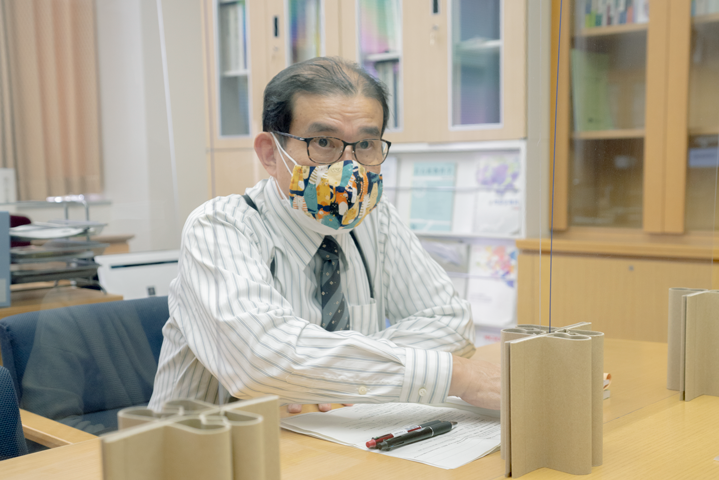
The academic year 2020 was a hard year for first-year students to get to know each other. At a symposium that I recently attended, it was pointed out that virtual face-to-face classes during the pandemic posed a crisis for first-year students as they failed to make new friends, which is a very important social aspect of student life. I had a chance to talk with one professor who decided to conduct all his classes online for the spring semester 2020 sometime around February. He said that face-to-face classes should be resumed despite challenges, as he saw students happily coming back to class in the fall semester. In some of the joint academic programs that Kyoto University students participated in, they had to give up on attending classes which were held only on-site for training, but not online. As the pandemic raged on, we received reports from different departments that the number of students who have lost their motivation to attend online classes or laboratory experiments increased, and that there are many students who do not dare to go for counseling. Our counseling room staff have done a great job, but that may not be enough. In addition to the counseling room service, I would like each and every department to continue its efforts to follow up on the students who are in need of counseling, while practicing COVID-19 preventive measures. At the Faculty of Science, for example, a counseling office was set up, and the office has held weekly consultations on the LINE app. Students participating in the consultations exchange messages and encourage each other to keep up their motivation. We also asked our faculty members to maximize the small-group mentor framework to facilitate interactions among students.
Likewise, I would like to ask each department to do all they can to create open lines of communication and networking for their students, while rigidly following COVID-19 protocols. In April 2020, the Faculty of Science created a hangout spot in a less populated area of the building, and gave autonomy in the management of the area to about 10 of the students who visit the counseling office. As the COVID-19 evolved further, the physical hangout spot was temporarily closed, but since then, the members have hosted a LINE chat room on a weekly basis to exchange each other’s updates. That’s how they have maintained their motivation. Our responsibility is thus to create a platform where students feel comfortable to meet new friends and chat. If the faculty members in every department mentor about 10 students each as a class or unit, students will be able to gradually expand their network and stay motivated to study at Kyoto University.
The Future of FD and Education at Kyoto University
In light of the COVID-19 crisis, Kyoto University faculties have responded well to the immediate transition from off-line to online/hybrid teaching in a short period of time, and kept the momentum of teaching and learning going to come thus far. Not only seminars, but also our faculties’ willingness to share information and experience helped smooth the transition. Dr. Hirajima, how do you evaluate Kyoto University’s FD during the past year? What will be the future challenges faced by Kyoto University?
The rapid online transition triggered by the COVID-19 pandemic this year resulted in boosting cross-department collaboration and internal communications where faculties learned from each other’s teaching practices. I should also note that the internal seminar series “My Online Class @ Kyoto University” that the Center for the Promotion of Excellence in Higher Education organized on a weekly basis has accelerated the speed of information exchange among faculties. What is also worth acknowledging is that the seminar series was recorded and made available online so that faculties could watch them at their own convenience and learn about the efforts of each department. It must have been really convenient for the users. Above all, all faculty members and administrative staff worked very hard to undergo a digital transformation, which wouldn’t have been ever possible without their understanding and support.
Lastly, I hope Kyoto University’s FD program continues to progress across the boundaries of departments, and raise the awareness of faculty members and administrative staff toward quality higher education.

Photos by Mr. Masahiro Okada (Kyoto University Center for the Promotion of Excellence in Higher Education, Administrative Assistant)
A Trivial Episode
“Let’s Play with Numbers” by Murako Kinuta, Shogakukan Inc.
This manga is a story about one student from the countryside who enrolls the Faculty of Science at Yoshida University, and suffers setbacks in his first-year mathematics class. The story overlaps with my own experience so much that I doubted whether some mathematics professors from Kyoto University’s Faculty of Science took part the original story line. Luckily I could avoid repeating a year, but I went through almost the same series of setbacks as the lead character does. (By Dr. Hirajima)
List of Interviews


